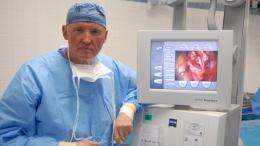Breakthrough in 3-D Brain Mapping Enables Removal of Fist-Sized Tumor

(PhysOrg.com) -- A new technology involving the fusion of four different types of images into a 3-D map of a patient's brain has helped University of Cincinnati (UC) specialists successfully remove a fist-sized tumor from the brain of an Indiana woman.
The surgery was performed at University Hospital by an eight-member team from the Brain Tumor Center at the UC Neuroscience Institute.
"This marks the culmination of one of the most important developments in brain tumor surgery in the last 100 years," says John Tew, MD, a neurosurgeon with the Mayfield Clinic, UC professor of neurosurgery and clinical director of the UC Neuroscience Institute.
The multiple brain scans were fused and installed into a surgical guidance computer, whose function is similar to a global positioning system. By revealing the tumor's relationship to all of the functional centers, electrical pathways and arteries and veins in the patient's brain, the technology enabled Tew and his team to map out a safe pathway to the tumor.
The processing and fusion of images was performed by James Leach, MD, associate professor of neuroradiology at UC, and a neuroradiologist at Cincinnati Children's Hospital Medical Center and the UC Neuroscience Institute, using the BrainLAB iPlan system at University Hospital.
"This fusion of images is exciting in that it allows us to maximize resection (removal) of the tumor while preserving function for the patient," Leach says.
Since early 2007 Brain Tumor Center specialists have used the fusion of three types of imaging as a guide to stereotactic surgery:
- Magnetic resonance imaging (MRI), which creates detailed pictures of the body by detecting differences in magnetic signals between different types of tissues.
- Functional magnetic resonance imaging (fMRI), which creates a series of images that capture blood oxygen levels in parts of the brain that are responsible for movement, perception and cognition.
- Diffusion tensor imaging (DTI), which provides a map of critical white-matter tracts, which facilitate electrical connections between different parts of the brain.
In the latest development, Leach added the fusion of computed tomography angiography (CTA), which provides a map of blood vessels (arteries and veins).
"The ability to completely map the brain and to understand—before we operate—where the tumor lies in relation to important structures is a milestone in our use of digital computer technology to heighten patient safety during complex brain tumor surgery," Tew says.
The fMRI and DTI studies were performed on University Hospital's 3T MRI system. "The 3T system allows us to image the functional areas of the brain using various language, motor and vision tasks with the patient in the MRI scanner," Leach explains. "The addition of the DTI sequence allows the connections between these areas and other parts of the nervous system to be identified at the same time."
FMRI scanning takes approximately 75 minutes, about 30 minutes longer than traditional MRI. The DTI scan, which takes five minutes, is performed in the same setting.
CTA scanning was performed at University Hospital.
Leach processed the images, highlighting the location of speech and movement areas, white matter tracts and arteries and veins. He also highlighted the tumor location, then imported all of the information into BrainLAB's navigation software at University Hospital.
Assisted by the three-dimensional brain-mapping, Tew and his team were able to navigate a trajectory through the patient's brain and remove 90 percent of the malignant tumor, an anaplastic astrocytoma, without harming the healthy brain tissue—including the deep nerve-fiber tracts—that surrounded it. The patient was talking normally right after surgery, and she was walking the halls and able to take a shower without assistance one day after surgery.
The team sought to eradicate the remaining tumor by applying a course of 33 computer-guided, fractionated radiotherapy treatments as a first approach. During fractionated radiotherapy, a small burst of radiation is delivered to the lesion every day over a period of weeks. Delivering radiation in this way, rather than in a single, concentrated session, allows healthy tissue to recover in between treatment sessions. The patient underwent those treatments at the Precision Radiotherapy Center in West Chester.
Concurrently, the patient underwent treatment with a chemotherapy agent (temosolomide). If the radiotherapy and chemotherapy are not effective, she could face another operation.
Source: University of Cincinnati Academic Health Center













